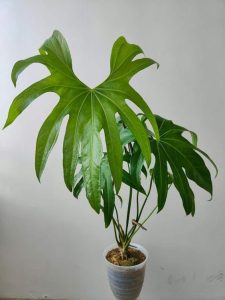Anthurium Fingers

- Botanical Name: Anthurium Pedatoradiatum
- Family Name: Araceae
- Stems: 1-3.3 inches
- Temperature: 18℃-24℃
- Other: warm & humid , indirect light, moisture.
Overview
Product Description
Anthurium Fingers: The ‘Finger’ Wizard of the Tropical Rainforest

Anthurium Fingers
Anthurium Fingers, also known as Anthurium pedatoradiatum, is a unique and captivating tropical plant renowned for its striking leaf shape. Native to the tropical rainforests of Central and South America, particularly the southern regions of Mexico, this plant thrives in the warm and humid climate typically found in tropical environments, making it a popular choice among indoor plant enthusiasts.
Royal Leaf Grandeur
The most notable feature of Anthurium Fingers is its leaves, which are distinctively shaped with multiple finger-like extensions resembling a human hand. Mature plants can have up to thirteen “fingers” per leaf, while younger plants display heart-shaped leaves. These leaves are not only uniquely shaped but also vibrant in color, usually a deep green with distinct white veins, adding a touch of tropical flair to any indoor setting.
Anthurium Fingers Habitat Preferences
This plant prefers warm and humid conditions, requiring bright indirect light to avoid sunburn on its leaves. It is not overly particular about temperature, with an ideal range of 18 to 25 degrees Celsius. Anthurium Fingers also demands a certain level of humidity, thriving in high-humidity environments. Therefore, increasing indoor humidity or placing it in naturally humid areas like bathrooms can aid its growth.
Anthurium Fingers Tropical Adaptability
The leaf morphology of Anthurium Fingers, with its finger-like lobes, is an adaptation to the tropical rainforest environment. In this setting, plants must capture as much light as possible within the limited space under the dense canopy, and the unique leaf shape of it helps it to capture more light within the crowded treetop layer. This shape may also help the plant maintain humidity in the rainforest’s microclimate, as the larger surface area slows down water evaporation.
Growth Tips For Anthurium Fingers
It’s important to note that the leaf shape of Anthurium Fingers changes as it grows, evolving from a heart shape to a mature form with multiple lobes. This transformation not only showcases the plant’s growth process but also reflects its adaptability to different environmental conditions. As the plant matures, the number of “fingers” on its leaves may increase, up to a maximum of thirteen, thereby maximizing the surface area for photosynthesis.
Anthurium Fingers Tropical Elegance
Due to its unique appearance and relatively easy care requirements, Anthurium Fingers is increasingly adored by indoor plant enthusiasts worldwide. Its leaf shape and tropical origin set it apart from other common indoor plants, making it a highly sought-after plant collection.
Anthurium Fingers Indoor Embellishment
Anthurium Fingers are suitable for placement among tropical plant collections and can also serve as air-purifying plants, helping to eliminate common indoor toxins. They are well-suited for warm, high-humidity locations such as bathrooms and kitchens but should be avoided near heating vents or drafty doors. Additionally, they can be integrated into various home decor styles as a design element, adding a touch of natural beauty to indoor environments。
Anthurium Fingers, the ‘finger’ wizard of the tropical rainforest, has captured the hearts of plant enthusiasts with its unique leaf shape. This plant is not only famous for its “finger”-like leaves but also for being easy to care for and adaptable to indoor environments, making it an ideal home decor choice. From the tropical rainforests of southern Mexico to the global stage,it showcases its unique growth posture in different humidity and temperature conditions. Whether in the steamy atmosphere of a bathroom or the lively ambiance of a kitchen, it maintains its royal elegance. Over time, its leaves transform from a heart shape to a mature form with up to thirteen “fingers,” showcasing not only a remarkable journey of growth but also its flexible adaptation to environmental changes. It is not just a fashion icon in the plant world but also a source of natural charm for indoor decoration.










